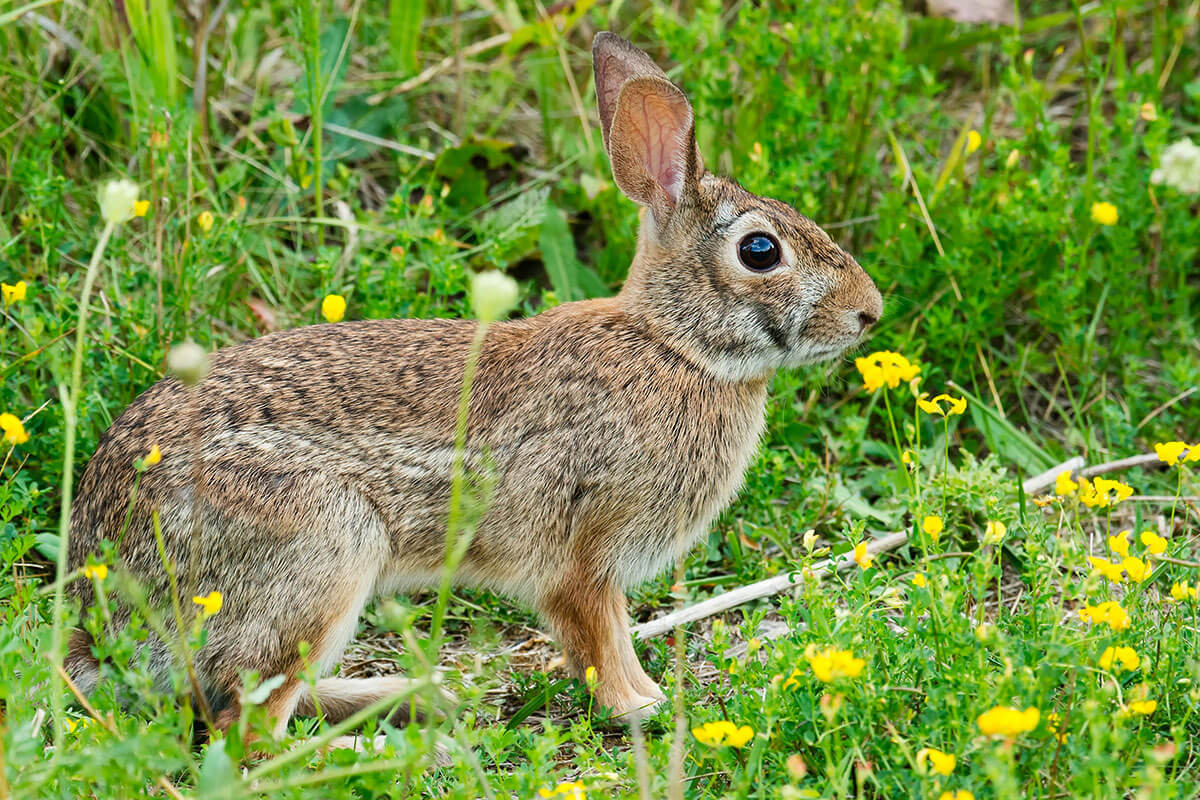Eastern Cottontails

The eastern cottontail is the most common of all American rabbits. It is found from southern Manitoba and Quebec to Central and Northwestern South America. In the U.S., the eastern cottontail ranges from the East Coast to the Great Plains.
Physical Attributes
- Weight: 2 – 4 LBS (900 – 1,800 grams).
- Adult eastern cottontails grow to 14" – 18" (375 – 463MM) long.
- Dense, buffy brown underfur and longer, courser gray- and black-tipped guard hairs cover the back of the eastern cottontail.
- Rump and flanks are gray, and it has a prominent reddish patch on its nape.
- Ventral surface is white.
- The eastern cottontail shows the white underside of its short tail when it is running.
- Spring molt, lasting from mid-April to mid-July, leaves a short summer coat that is more brown.
- From mid-September to the end of October, the change to a longer, grayer coat occurs for winter.
- The eastern cottontail has four pairs of mammary glands.
- Has distinctive large eyes for its size.
Similar Species
The New England cottontail usually lacks rust-colored nape, and has a black patch between its ears. The desert cottontail is usually smaller, with slightly longer ears. Marsh and swamp rabbits have rust-colored feet. The snowshoe hair is usually larger and wears uniform dark brown fur in summer.
Food
The eastern cottontail is a vegetarian, and the majority of its diet is made up of complex carbohydrates and cellulose. The digestion of these substances is made possible by caecal fermentation. The cottontail reingests fecal pellets to reabsorb nutrients from its food.
Their diet varies between seasons. In the summer, green plants are favored. About 50% of the cottontail’s intake is grasses, including bluegrass and wild rye. Other summer favorites include wild strawberries, clover and garden vegetables. In the winder, the cottontail subsists on woody plant parts, including the twigs, bark and buds of oak, dogwood, sumac, maple and birch. As the snow accumulates, cottontails have access to the higher trunks and branches. Feeding activity peaks two to three hours after dawn and the hour after sunset.
Parenthood
During the breeding season (February – September), males fight one another and perform dance-like courtship displays before territorial females. These displays involve face-offs and much jumping, including females jumping over males. Individuals often jump straight up into the air, and pairs or small groups often engage in active chases.
A few days before the birth of her young, the female prepares a grass- and fur-lined nest. The nest is usually in a hollow beneath a shrub or a log, or in tall grass. Litter sizes vary from 2 to 8 bunnies, with an average of 5 to 6.
The newborns weigh 0.9 – 1.3 ounces (25 – 35 grams), and are helpless at birth. They are blind and naked. The young grow rapidly, initially about 0.09 ounces (2.5 grams) a day. Their eyes open around day 4 or 5, and they can leave the nest after about 2 weeks. The litter receives minimal care from their mother; they are nursed once or twice daily. Weaning occurs between 16 – 22 days. Littermates become intolerant of each other and leave the nest around 7 weeks of age. The female mates soon after birthing, and she is often near the end of gestation as the current litter is leaving the nest.
Behavior & Habitat
The eastern cottontail is primarily nocturnal, but is abroad near dawn and dusk and often on dark days. Cottontails usually hop, but they can leap 10 to 15 feet (3 – 4.5 meters). When pursued, they usually circle their territory and often jump sideways to break their scent trail. They dislike getting web, but will swim if pressed. In winter, where brush is strong enough to hold a covering blanket of snow, they may make a network of runways beneath it. In cold weather, they often take shelter in woodchuck burrows.
Eastern cottontails are solitary animals, and they tend to be intolerant of each other. Their home range is dependent on terrain and food supply, usually between 5 and 8 acres, increasing during the breeding season. Males generally have a larger home range than females. The eastern cottontail has keen senses of sight, smell and hearing.
During daylight hours, the eastern cottontail remains crouched in a hollow under a log or in a thicket or brush pile. Here, it naps and grooms itself. The cottontail sometimes checks the surroundings by standing on its hind legs with its forepaws tucked to its chest. Escape methods of the eastern cottontail include freezing and or “flushing”. Flushing consists of escaping to cover by a rapid and zig-zag series of bounds. The cottontail is a quick runner and can reach speeds of up to 18 miles per hour. Eastern cottontails are short-lived; most do not survive beyond their third year. Enemies include hawks, owls, foxes, coyotes, weasels and man.
Historically, the eastern cottontail inhabited deserts, swamps and hardwood forests, as well as rainforests and boreal forests. Currently, the eastern cottontail prefers edge environments between woody vegetation and open land. Its range of habitats includes meadows, orchards, farmlands, hedgerows and areas with second growth shrubs, vines and low deciduous trees.
References
- “Eastern Cottontail”, Nature and Wildlife database eNature.com
- The University of Michigan Museum of Zoology Animal Diversity Web
